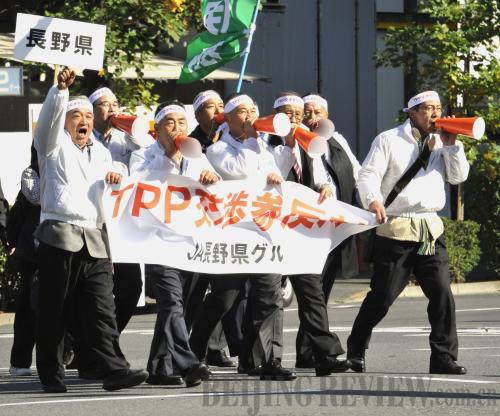|
 |
|
FARMING BACKLASH: Japanese farmers protest against the TPP pact in Tokyo on November 10, 2010 (XINHUA/AFP) |
The TPP presents a new model for economic and trade cooperation in the Asia-Pacific region, which might inject vigor into economic and trade relations in the region, she said. But many of the high standards the TPP has set are designed to serve U.S. interests, sparking doubts in a number of countries.
For instance, the United States proposed to cut tariffs on environmental goods such as solar panels to 5 percent or lower. Since average U.S. tariffs on these products are 1.4 percent, the new proposal will not have any impact on the United States, but can help it penetrate other countries' markets.
Chinese experts said the TPP, as it stands, looks more like a tool for the United States to promote exports. Mei Xinyu, an associate research fellow with the Chinese Academy of International Trade and Economic Cooperation, said after the global financial meltdown, the Obama administration attached unprecedented importance to export strategies to boost economic growth and reassert U.S. influence.
Since Europe has been troubled by the sovereign debt crisis, and Canada and Latin America face problems such as weak growth and limited market capacity, the Asia-Pacific region has naturally become the top choice for U.S. exporters, he said.
Given its voluntary nature, APEC can hardly meet U.S. demands for the quick and compulsory opening of markets, nor can it respond to U.S. calls to attach political strings to trade. That's why Washington has turned to the TPP as an alternative, Mei said.
Analysts argued the TPP initiative, despite its focus on free trade, has strategic implications for the Asia-Pacific region.
The TPP has become a "battleground for influence" in the Pacific region between China and the United States, said Simon Tay, Chairman of the SIIA, during an interview with the Council on Foreign Relations, a U.S. think tank based in New York City and Washington, D.C. Tay said the TPP will be a "game changer" for U.S. presence in the region.
U.S. economic engagement in Asia has been on the decline over the last decade and it has also lagged behind in the development of free trade areas (FTAs) in the region, said Joshua Meltzer, a research fellow with the Brookings Institution.
According to Meltzer, the United States has finalized FTAs only with Australia, Singapore and South Korea, while from 2000 to 2009, the number of FTAs in Asia increased from three to 54 and another 78 are under negotiation.
"U.S. absence from this proliferation of rule-making in Asia has limited the nation's role in designing the rules under which increasing amounts of trade and investment are occurring," Meltzer said.
Meltzer also pointed out that Asian economic architecture has matured in the past decade. A range of forums have been established for discussing economic goals, such as APEC, the ASEAN Plus Three mechanism (the Association of Southeast Asian Nations plus China, Japan and South Korea) and the East Asia Summit, which the United States has recently joined.
"Ensuring that the United States plays a key role in shaping Asian economic architecture will also affect its influence in the region," Meltzer said.
The United States cannot afford to allow its presence in the Asia-Pacific region to weaken. After a decade of war in Iraq and Afghanistan, the Obama administration is bringing the United States back to Asia.
U.S. Secretary of State Hillary Clinton declared that this century will be "America's Pacific century" during a speech at the East-West Center in Honolulu on the sidelines of the APEC Summit.
"One of the most important tasks of American statecraft over the next decades will be to lock in a substantially increased investment—diplomatic, economic, strategic, and otherwise—in this region," Clinton said.
Obama's Asia-Pacific trip on November 11-19 also demonstrated Washington's increasing commitment to the region. After the APEC Summit in Hawaii, he visited Australia to celebrate 60 years of the U.S.-Australian alliance. He also made his debut at the East Asia Summit in Bali, Indonesia.
(Reporting in New York City with additional reports from Yan Wei in Beijing)
APEC Summit Outcomes
Ma Zhaoxu, a spokesman for the Chinese delegation, outlined the achievements of the Honolulu APEC Summit on November 13 as follows:
- Consensus on innovation policies, the development of small and medium-sized enterprises and battling trade protectionism
- Commitment to cutting tariff rates on environmental goods to 5 percent or less by the end of 2015, while taking into account individual economies' economic circumstances and without prejudice to their positions in the WTO
- Commitment to cutting the region's aggregate energy intensity by 45 percent by 2035
- Pledge to encourage all APEC members to take steps by 2013 to implement good regulatory practices, including ensuring internal coordination of regulatory work, assessing regulatory impacts and conducting public consultation
(Source: Xinhua News Agency) | 